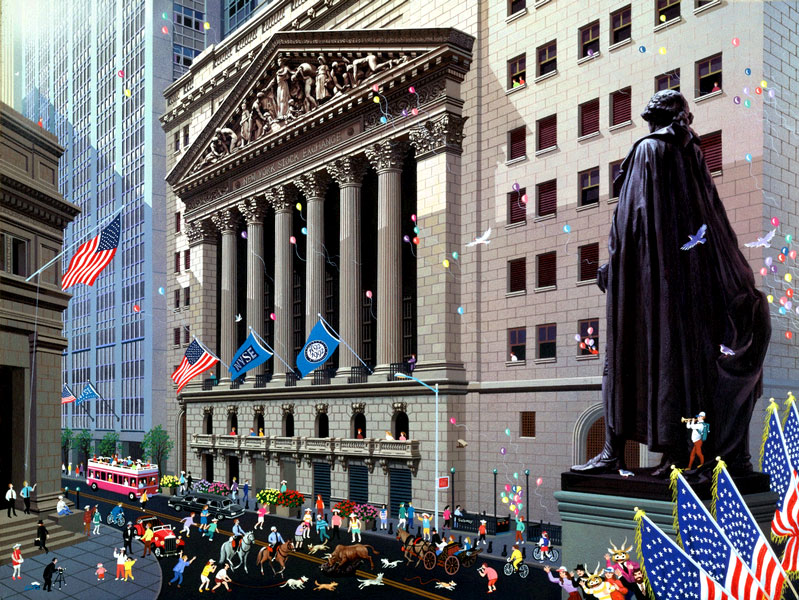What is said on Wall Street about the Fed and the anti-crisis scuffles between Republicans and Democrats

The comment on the financial markets by Giuseppe Sersale, strategist of Anthilia Capital Partners Sgr
Last night, the Fed basically confirmed the change in its mandates, extending forward guidance on rates: these will remain at current levels until the labor market returns to full employment, and inflation returns to 2% and it will show the ability to keep moderately above that level for some time.
The guidance is confirmed by the Dot plot, which shows that the Committee believes that the Fed Funds will remain at 0-0.25% until 2023, when the projections estimate the return of the PCE inflation to 2%. The conditions must all be met to kick-start the hikes, and two of them, “maximum employment” and “moderately exceed 2%” are vague enough to give the Fed a lot of leeway.
Among other things, as Tim Duy notes, the Fed implicitly promises real rates at -2%, if inflation is actually at 2% in 2023 and the Fed Funds still at 0-0.25%. A decidedly dovish picture.
So why the negative market reaction, with stocks and gold falling, and yields rising?
I would say that there is a combination of 2 reasons:
1) the haste with which Powell had rushed to Jackson Hole to modify the mandates on inflation and employment has perhaps led some to think that the policy mix would change immediately, perhaps with a change in the purchasing program towards a greater duration, or more purchases of mortgages. Instead, the Fed is rightly in no hurry, and this may have disappointed a spoiled market.
2) With the Fed behind us, investors' attention returns to focus on other catalysts, including a triple witching (technical maturity of futures and options) tomorrow that promises to be troubled, by virtue of what emerged in recent weeks about it of the operations of Softbank, and of retail. And a second topic that is gaining weight is the presidential election. Usually the last 6 weeks are those in which the influence unfolds on the markets. This round promises to be particularly uncertain, with Trump still at a disadvantage, but in trend recovery until a few days ago. To complicate the situation, the high probability that Donald, in the event of a defeat of measure, will contest the result, prolonging the stalemate and uncertainty and contributing to agitating a now extremely polarized political landscape.
The fact is that the US indices, after an initial attempt to rally, reversed their gear to close in negative (S&P 500 – 0.46%) led by the Nasdaq 100 (-1.67%). That the Fed is not the only reason for the decline is shown by the dispersion of performance between sectors, with heavy tech software etc, and sectors such as financials and industrials in progress.
The weakness continued in the Asian session, with rapid futures accumulating further losses. An invitation from Trump to Republicans in the Senate to raise the amount of the tax package has had no effect on sentiment, also because the response has been apparently lukewarm , with the head of the majority declaring that the higher the amount of the package, and the less likely the Senate will vote it. Instead, Democratic leaders Pelosi and Schumer said they were encouraged by the Trump initiative.
The fiscal stimulus situation in Congress seems paradoxical. The Democrats don't have much interest in agreeing: the practical result of launching a package would be that Trump could appropriate it for election purposes (perhaps delivering other checks to the Americans with his name written on it). Better to let the electorate understand that if they enter the White House and have a majority in Congress, they will launch a galactic plan after the elections. Republicans are the most interested in agreeing. But the Democrats will pull the rope to the point that, if there is an agreement, it will be clear that they prevailed. With Trump pushing, a solution in extremis cannot be ruled out, but personally I believe that the donkey party will play higher, to avoid an agreement and go to the Presidential in full fiscal cliff.
The Asian session was obviously affected by the cold US wind, with all the main indices falling, although in reality, apart from Hong Kong, the declines do not entirely reflect the decline of Wall Street plus the drop in overnight futures (S&P 500 and Nasdaq were down by over 2 points at the end of the Asian session). This shows once again that the weakness is specific to US indices, although of course any further declines will be reflected in global equities. Risk aversion was also reflected in exchange rates, with the dollar recovering.
Needless to say, European equities blamed early on as it closed with the S&P over 2% higher last night. Eurostoxx also amortized some of the losses of the S&P, and recovered something in the morning when these decreased somewhat. As usual, the banking sector is heavy, which has not benefited at all (at least at the moment) from the relaxation of the limits on the leverage ratio by the ECB , perhaps because it was expected.
In a morning download of macro data, the news on Brexit made more noise. Johnson accepted the amendment submitting any measures contrary to the withdrawal agreement to a parliamentary vote. This increases the likelihood that the bill will be approved in the House of Commons, although difficulties could arise in the House of Lords, which can postpone approval for up to 12 months. On the part of the EU, various exponents declared that the amendment does not change the substance and reiterated that the contested clauses must be removed by the end of September.
This is a machine translation from Italian language of a post published on Start Magazine at the URL https://www.startmag.it/mondo/che-cosa-si-dice-a-wall-street-della-fed-e-delle-baruffe-anti-crisi-fra-repubblicani-e-democratici/ on Fri, 18 Sep 2020 07:47:53 +0000.
